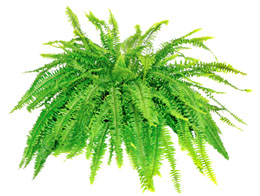Boston fern is a popular variety of fern that you may see decorating the balconies of several houses. If you, too, want to beautify your home by planting this variety of fern, then this article will tell you everything that you want to know.

The Boston fern was one of the most popular houseplants in the 19th century. Native to Central America, it became a household name during the Victorian era. The Latin name for the fern is
Nephrolepis exaltata. The plant is popular because it grows quickly and can, therefore, be used as a fill-in plant or a backdrop plant in landscaping.
Characteristics
The Boston fern is a herbaceous, evergreen plant that can be as small as 6 inches in size or as tall as 7 feet in height. The spread of the fern is generally about 2 to 3 feet wide, and it can vary greatly from plant to plant. The leaves called fronds are apple green in color and look sword-like. They grow in clusters from the base and are alternately arranged. It does not produce fruit but spores. The spores are found in small clusters called sori and lie between the midrib and the left margin, on the underside of the leaflet.
The plant is shade tolerant and thrives in moist soil. It prefers humid and warm environment to grow. In the wild, it is generally found growing around swamps, forests, and roadsides. It needs well-drained soil.
How to Care
When growing this houseplant, you need to ensure that proper conditions are maintained. You should keep in mind that these plants need high humidity and indirect light. In case of indoor gardening, you need to ensure that the humidity levels are taken care of. Fill a tray with pebbles, pour water into it and place the fern pot in it. Mist the plant 1 - 2 times every week so that its humidity needs are met.
It also includes keeping the soil damp. If the soil becomes dry, the fern plants die out. Therefore, make sure you water the plant as and when the soil seems dry. You can even soak the plant once a month. These plants are generally planted in peat moss and therefore, need to be kept moist. Drain the water properly after soaking the pot. If you find that the leaves are turning yellow, it means it needs more humidity.
Another aspect of proper care is fertilizing. You need to add a balanced 10-10-10 water-soluble liquid houseplant fertilizer to the plant just a few times in a year. They do not need a lot of fertilizer for their growth. But the plants are susceptible to pests, like spider mites and mealybugs. Therefore, treat the plant immediately, if you observe any kind of infestation. Do not use chemicals to treat the infestation. Instead use some natural insecticides to treat the plants.
If the leaves of the plant are turning gray, then it may be time to re-pot the plant. When you bring home a new plant, you may need to allow it time to adjust to its environment. Place the fern in the brightest area of your house, for at least a week. After that you can move it to the place where you want to keep it. This helps it to adjust to low light levels.
Caring for this plant is very easy and does not require extra efforts. However, one needs to take some care regarding humidity, soil moisture, and sunlight. If you are able to provide the ideal conditions, your fern will flourish.






 The Boston fern was one of the most popular houseplants in the 19th century. Native to Central America, it became a household name during the Victorian era. The Latin name for the fern is Nephrolepis exaltata. The plant is popular because it grows quickly and can, therefore, be used as a fill-in plant or a backdrop plant in landscaping.
The Boston fern was one of the most popular houseplants in the 19th century. Native to Central America, it became a household name during the Victorian era. The Latin name for the fern is Nephrolepis exaltata. The plant is popular because it grows quickly and can, therefore, be used as a fill-in plant or a backdrop plant in landscaping.